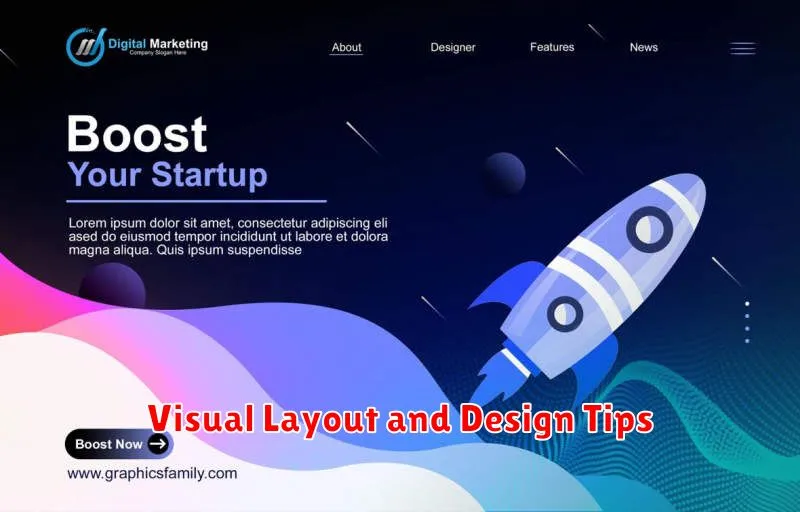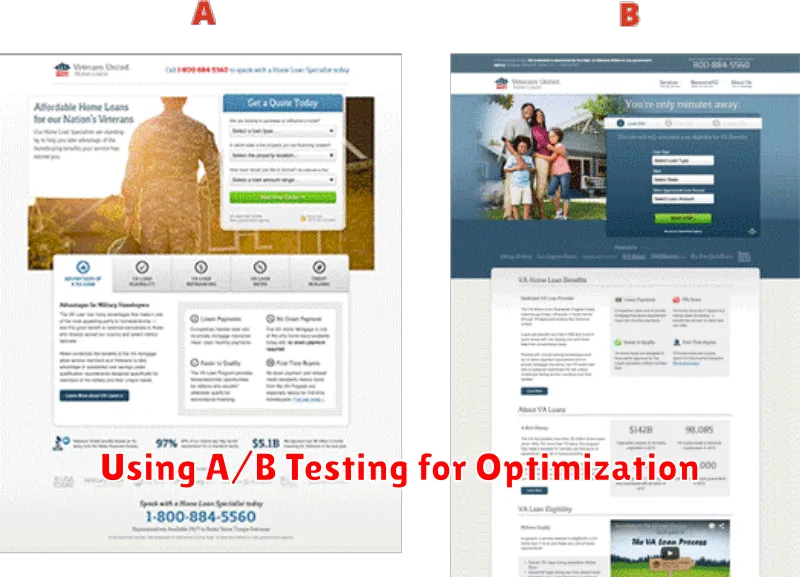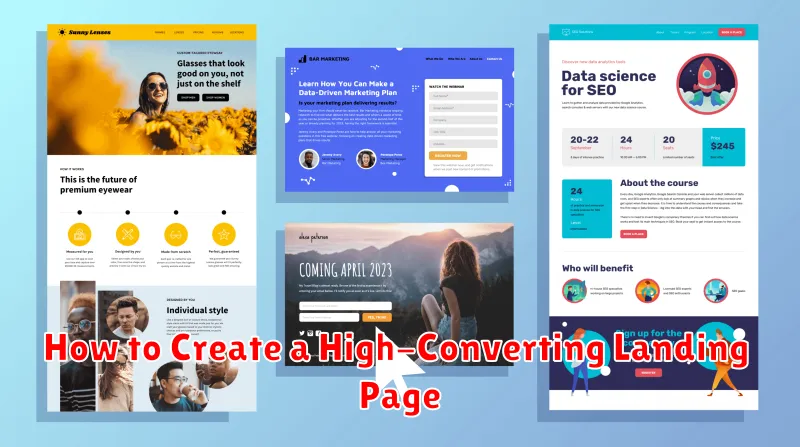Creating a high-converting landing page is crucial for any successful online marketing campaign. A landing page isn’t just a pretty webpage; it’s a strategically designed destination built with a single, focused objective: converting visitors into leads or customers. Whether you’re aiming to generate leads, drive sales, or promote a specific offer, understanding the key elements of a high-converting landing page is essential for maximizing your return on investment. This article will delve into the proven strategies and best practices that will empower you to create landing pages that truly deliver.
From crafting compelling headlines and persuasive copy to optimizing for conversions and A/B testing, we’ll cover everything you need to know to build a high-converting landing page. Learn how to define your target audience, craft a clear call to action, and design a visually appealing layout that guides visitors towards the desired action. By implementing these techniques, you can transform your landing pages from passive online real estate into powerful engines for lead generation and sales conversions.
Purpose and Role of Landing Pages
A landing page is a standalone web page, distinct from your main website, created with a specific objective in mind. Its primary purpose is to convert visitors into leads or customers. Unlike other pages on your website that might serve multiple purposes, a landing page is highly focused on a single call to action. This focus minimizes distractions and encourages visitors to take the desired action, whether it’s signing up for a newsletter, downloading a resource, or making a purchase. Landing pages are essential tools for targeted marketing campaigns.
The role of a landing page is to guide visitors towards a predetermined conversion. This is achieved by providing compelling content and a clear value proposition that aligns with the visitor’s initial interest. For instance, if a user clicks on an ad for a free ebook, the landing page should prominently feature information about the ebook and a simple form to download it. By streamlining the user experience and removing unnecessary navigation elements, landing pages optimize conversion rates and provide valuable data for analyzing campaign effectiveness.
Effective landing pages employ several key strategies to achieve their goals. These often include a compelling headline, concise and persuasive copy, visually appealing design, and a prominent call to action. Furthermore, successful landing pages prioritize mobile responsiveness and fast loading times to ensure a positive user experience across all devices. By carefully crafting these elements, businesses can maximize the impact of their marketing efforts and drive tangible results.
Core Elements Every Page Needs

Every webpage, regardless of its purpose, requires certain fundamental elements to ensure usability, accessibility, and effective communication. These core components contribute to a positive user experience and help search engines understand the content.
Firstly, a clear and concise page title is crucial. This element, displayed in the browser tab or window title bar, should accurately reflect the page’s content and incorporate relevant keywords. Secondly, headings (H1-H6) are essential for structuring the content and providing a hierarchical organization. The main heading (H1) should clearly state the topic of the page, while subsequent headings break down the content into smaller, digestible sections. Finally, well-written and informative content is paramount. This includes text, images, videos, or any other media that conveys the intended message to the user.
Beyond these fundamental elements, additional components can enhance the user experience. A well-structured navigation menu facilitates easy movement between different sections of the website. Meta descriptions, while not visible on the page itself, provide concise summaries to search engines and users in search results. Alt text for images improves accessibility for users with visual impairments and provides context to search engines. These secondary elements contribute to a more robust and user-friendly online experience.
Crafting Headlines That Hook
Headlines are arguably the most important element of any piece of content. They serve as the first, and often only, impression for potential readers. A compelling headline grabs attention, sparks curiosity, and ultimately persuades the audience to click through and engage with the content. A poorly crafted headline, on the other hand, can doom even the most brilliant writing to obscurity.
Effective headlines are concise and specific. They clearly communicate the value proposition of the content, telling the reader exactly what they can expect to learn or gain. Avoid vague or clickbait-y language that over-promises or misrepresents the content. Instead, focus on using strong verbs and keywords that accurately reflect the subject matter. Consider incorporating numbers, questions, or a sense of urgency to further pique reader interest.
Finally, remember to test your headlines. Different phrasing can significantly impact click-through rates. A/B testing different versions allows you to analyze performance and optimize for maximum engagement. By consistently crafting compelling headlines, you can effectively draw in your target audience and ensure your content reaches its full potential.
Call-to-Action Placement Best Practices
Effective call-to-action (CTA) placement is crucial for converting website visitors into customers. Placement should be strategic and based on user behavior and website flow. Highly visible locations above the fold, such as near the top of the page or alongside compelling content, often perform well. Consider placing CTAs where users are most likely to be receptive, such as at the end of a blog post or after presenting product information. Avoid overwhelming visitors with excessive CTAs, which can lead to banner blindness and reduced effectiveness.
Context is key when determining CTA placement. The message and offer of the CTA should align with the surrounding content. For instance, a CTA promoting a free trial might be effective after describing the benefits of a software product. Similarly, a CTA to “learn more” could be suitable after a brief introduction to a service. Ensure that the CTA button itself is visually distinct and uses action-oriented language, such as “Get Started,” “Download Now,” or “Sign Up Free.” Clear and concise wording helps visitors understand the desired action.
Testing and optimization are essential for maximizing CTA effectiveness. A/B testing different placements, designs, and messaging allows you to identify what resonates best with your audience. Analyze metrics such as click-through rates and conversion rates to refine your CTA strategy over time. Continuously monitoring and adjusting your approach is critical for improving website performance and achieving your business goals.
Visual Layout and Design Tips

Visual hierarchy is key to effective design. Guide the viewer’s eye by using size, color, and contrast to emphasize important elements. Think about what you want the user to see first, second, and third. Proper use of whitespace can also improve readability and create a more visually appealing design. Avoid cluttering the layout with too many elements, allowing for breathing room around key information.
Consistency creates a unified and professional look. Maintain consistent fonts, colors, and spacing throughout your design. This creates a sense of harmony and makes the information easier to digest. Develop a style guide to ensure consistency across different platforms and mediums.
Consider the target audience and the purpose of your design. A website for a children’s toy store will have a very different visual style than a website for a law firm. Understanding your audience will help inform design choices such as color palette, font selection, and overall tone.
Trust Signals and Testimonials
Trust signals are visual cues that increase user confidence and encourage conversions. These signals demonstrate credibility and reliability, helping visitors feel more secure about interacting with a website or business. Important examples include security badges (like SSL certificates), customer reviews, testimonials, guarantees, return policies, contact information, and professional design elements. By incorporating these signals strategically, businesses can build trust with their audience and improve their overall online reputation.
Testimonials, a specific type of trust signal, offer social proof by showcasing positive experiences from previous customers. They provide valuable insights into the benefits of a product or service, directly addressing potential customer concerns. Effective testimonials are authentic, specific, and relatable. They can take various forms, such as written reviews, video clips, or case studies. High-quality testimonials build confidence and can be a powerful tool for driving conversions.
Building trust is an ongoing process. Regularly gathering and showcasing testimonials, ensuring website security, and displaying clear contact information are crucial for maintaining a trustworthy online presence. By prioritizing these elements, businesses can cultivate strong customer relationships and establish themselves as reliable providers.
Using A/B Testing for Optimization

A/B testing is a powerful method for optimizing websites, apps, and marketing campaigns. It involves comparing two versions (A and B) of a single variable, where version A is the original and version B is the modified version. By showing these versions to different groups of users, you can measure which performs better based on key metrics like conversion rates, click-through rates, or engagement.
The process typically involves defining a clear hypothesis about how the change in version B will impact the chosen metric. Then, traffic is split between the two versions, and data is collected. Statistical analysis is then used to determine if the observed difference in performance between A and B is statistically significant. This helps avoid making decisions based on random chance and ensures that the changes you implement actually lead to improvement.
Common examples of A/B testing include comparing different headlines, call-to-action buttons, images, or even entire page layouts. By iteratively testing and refining, businesses can continuously optimize their user experience and improve their bottom line.
Loading Speed and Mobile Responsiveness
Loading speed is a critical factor for website success. A fast-loading website provides a better user experience, leading to increased engagement, higher conversion rates, and improved search engine rankings. Slow loading times, on the other hand, can frustrate users and drive them away, resulting in lost opportunities. Optimizing images, leveraging browser caching, and minimizing HTTP requests are key strategies for improving loading speed.
Mobile responsiveness ensures that a website adapts seamlessly to different screen sizes and devices. With the majority of internet traffic now coming from mobile devices, a responsive design is essential for reaching and engaging your target audience. A mobile-friendly website offers a consistent and user-friendly experience across all devices, from smartphones and tablets to desktops, boosting user satisfaction and accessibility.
Both loading speed and mobile responsiveness are crucial aspects of website performance and user experience. By prioritizing these elements, businesses can create websites that are both efficient and accessible, ultimately driving success in the digital landscape.
Integrating Email Capture Forms
Integrating email capture forms into your website is crucial for building a strong subscriber list and nurturing leads. Effective forms should be strategically placed, concise, and offer a compelling reason for visitors to subscribe. Common placements include pop-ups, embedded forms within content, and dedicated landing pages. Remember to clearly communicate the value proposition, such as exclusive content, discounts, or updates.
Several methods exist for integrating these forms. You can use dedicated email marketing platforms like Mailchimp or Constant Contact, which often provide embeddable forms and seamless integration with your existing campaigns. Alternatively, you can use website plugins or custom-built forms, though these require more technical expertise. Regardless of the method, ensure the form is mobile-friendly and loads quickly to avoid frustrating potential subscribers.
Testing and optimization are essential for maximizing conversions. Experiment with different form placements, copy, and calls to action. Analyze your results to determine what resonates best with your audience and refine your strategy accordingly. Consider A/B testing different variations to identify the most effective approach.
Post-Click Experience Optimization
Post-click experience (PCE) optimization is the process of improving every element that a user encounters after clicking an ad, from the landing page to the final conversion. A strong PCE is crucial for maximizing the return on your advertising spend (ROAS). By optimizing the experience, you reduce bounce rates, increase conversions, and improve the overall effectiveness of your marketing campaigns.
Key areas of focus for PCE optimization include message match (ensuring consistency between the ad and landing page), page load speed, mobile responsiveness, clear call-to-actions, and streamlined form design. These elements work together to create a seamless and persuasive user journey.
By investing in PCE optimization, businesses can significantly enhance their marketing ROI. A better user experience translates to more conversions, increased customer lifetime value, and ultimately, a more profitable marketing strategy.

